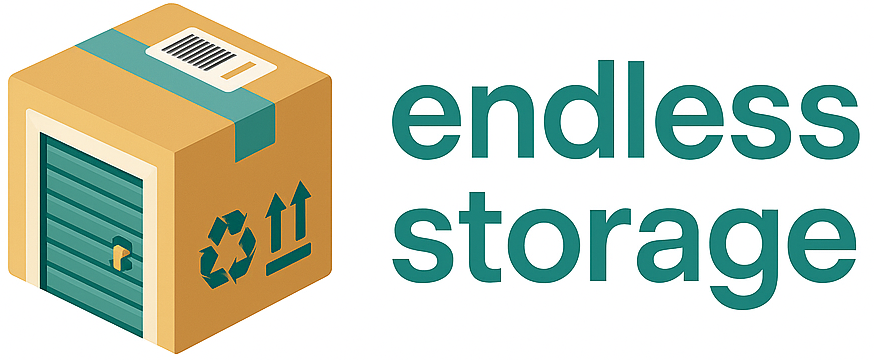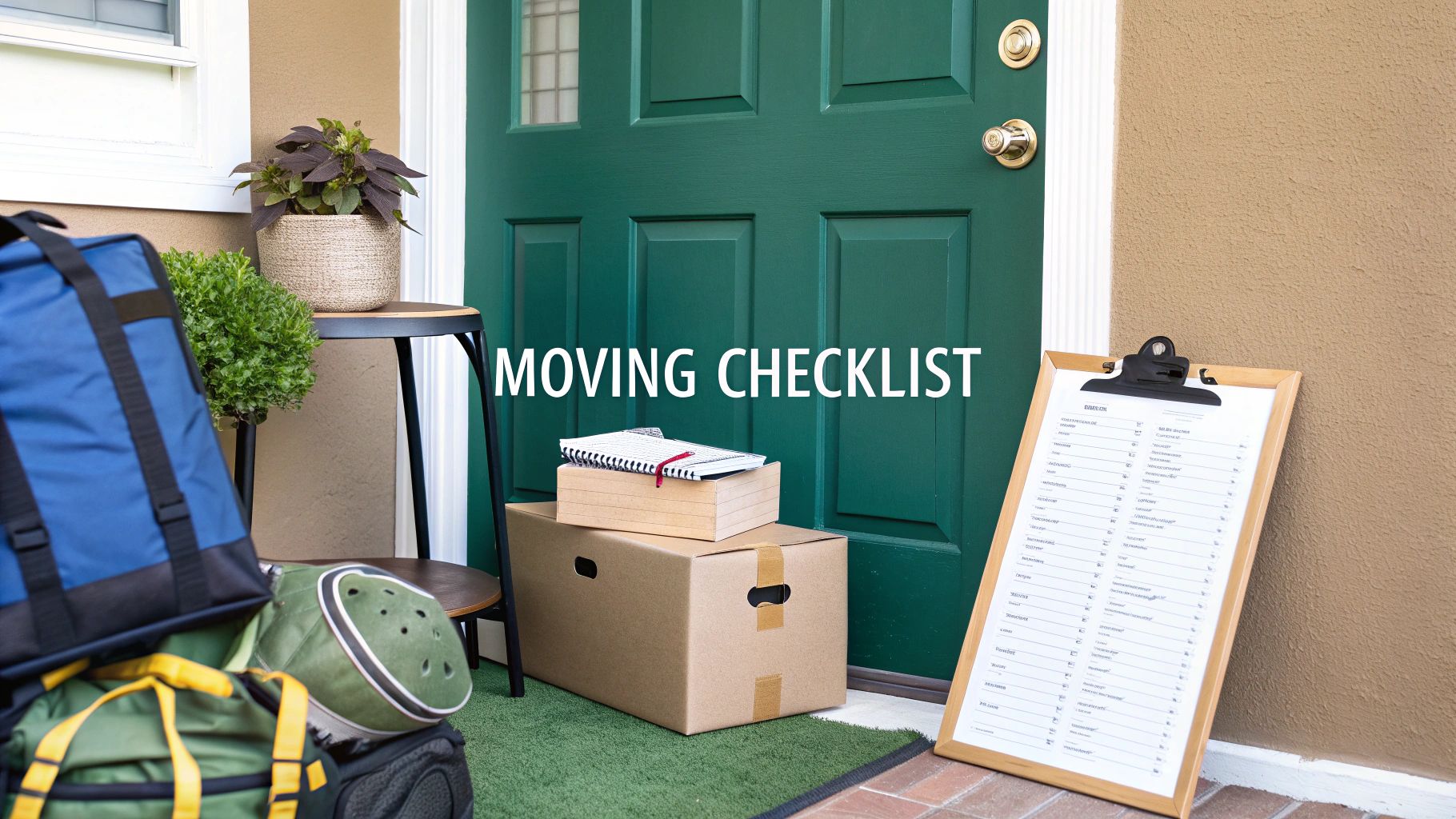Moving can feel like navigating a complex maze of tasks, deadlines, and decisions. It's easy to get overwhelmed, but a well-structured plan transforms a potentially chaotic experience into an organized, seamless transition. This guide provides a definitive checklist of the most critical things to do before you move, breaking down the entire process into concrete, actionable steps. By tackling these tasks systematically, you can prevent last-minute panic, save money, and ensure you arrive at your new home ready for a fresh start.
We'll go beyond the obvious "pack boxes" advice, offering strategic insights to streamline every aspect of your relocation. From creating a master timeline and researching movers to handling address changes and assembling a first-night survival kit, this blueprint covers all the essentials. For many, a seamless transition involves purchasing a new property, and following the essential steps to buying a house is fundamental to your pre-move blueprint. This comprehensive list is designed to give you clarity and control, turning the monumental task of moving into a manageable project. Let's dive into the specifics that will make your move successful.
1. Create a comprehensive moving checklist timeline
The single most effective strategy for a stress-free move is to stop thinking of it as one massive event and start treating it as a project with distinct phases. A comprehensive moving checklist timeline, starting 8-12 weeks before your move date, is the foundation for this approach. It systematically breaks down the entire process into manageable weekly tasks, ensuring nothing critical gets overlooked in the final-hour chaos. This method transforms an overwhelming ordeal into a series of achievable goals.
Why a Timeline is Essential
A well-structured timeline prevents the last-minute scramble that leads to forgotten tasks, extra expenses, and heightened stress. By assigning specific duties to each week, you create a clear roadmap. This is a standard practice for professional relocation specialists and military families undergoing a Permanent Change of Station (PCS), who rely on detailed schedules to manage complex logistics. For them, a timeline isn't just helpful; it's non-negotiable for a successful transition.
How to Build Your Timeline
Start with your move date and work backward. Plug in major deadlines first: giving notice to your landlord, booking movers, and scheduling utility transfers. Then, fill in the smaller tasks around these milestones.
- Use Digital Tools: Apps like Trello, Asana, or even a shared Google Calendar can help you track progress, set reminders, and assign tasks to family members.
- Build in a Buffer: Life happens. Add 20% extra time to your estimates for each major task. If you think packing the kitchen will take five hours, block out six.
- Be Granular: Instead of a vague entry like "Pack," break it down into "Pack non-essential items (books, decor)" for Week 6 and "Pack kitchen" for Week 2.
This timeline visualizes the key phases of your moving project, from initial planning to final preparations.
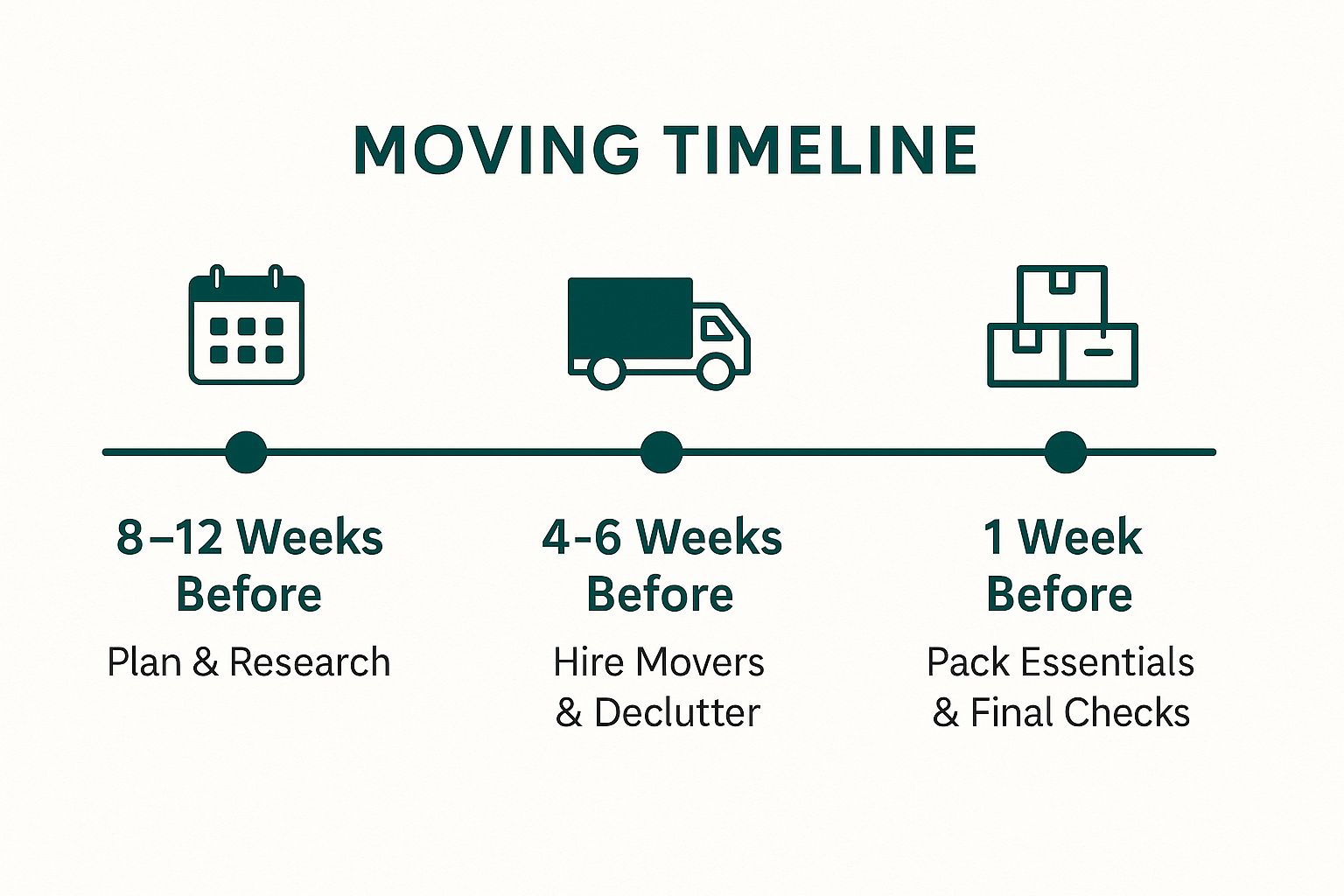
The visualization highlights how the focus shifts from broad research and planning in the early stages to more hands-on, action-oriented tasks as the move date approaches. For a complete breakdown, you can learn more about creating a comprehensive moving checklist and timeline on Endless Storage.
2. Research and hire reputable movers early
One of the most critical things to do before a move is to secure your moving company well in advance. Booking reputable movers 6-8 weeks out, especially during peak season (May through September), is not just about ensuring availability; it's a strategic move to secure better rates and avoid last-minute, high-stress decisions. This proactive step prevents you from settling for a less-than-reputable company due to a lack of options, safeguarding your belongings and your peace of mind.
Why Early Booking is Essential
Waiting too long to hire movers can result in limited choices, inflated prices, and a higher risk of encountering moving scams. Top-rated companies are often booked solid weeks or even months ahead. By researching and vetting companies early, you give yourself ample time to compare quotes, check credentials, and make an informed choice. This is a standard recommendation from consumer advocacy groups and the Better Business Bureau, who stress that due diligence is the best defense against fraudulent operators.
How to Find and Vet Movers
Begin by gathering at least three in-person or video-call estimates. This allows you to compare not just price, but the professionalism and thoroughness of each company's assessment.
- Verify Credentials: Check for a U.S. Department of Transportation (DOT) number for interstate movers and investigate their record on the Federal Motor Carrier Safety Administration (FMCSA) database.
- Check Reviews: Look at their ratings on the Better Business Bureau (BBB) and read recent customer reviews on multiple platforms to get a balanced view of their service quality.
- Understand Insurance: Ask detailed questions about their liability coverage. Basic "Released Value Protection" is minimal; you may need to purchase "Full Value Protection" for adequate coverage.
This structured vetting process ensures you partner with a trustworthy company capable of handling your move efficiently. For a deeper analysis, you can learn more about comparing moving company costs and finding the best value on Endless Storage.
3. Declutter and organize belongings systematically
Moving is a rare opportunity to re-evaluate every single item you own. By systematically decluttering, you not only reduce the volume (and cost) of what you move but also ensure you begin life in your new home surrounded only by things you need and love. This isn't just about tidying up; it's a strategic process of sorting every item into one of four categories: keep, sell, donate, or trash. Adopting this mindset is one of the most impactful things to do before a move for a fresh, organized start.
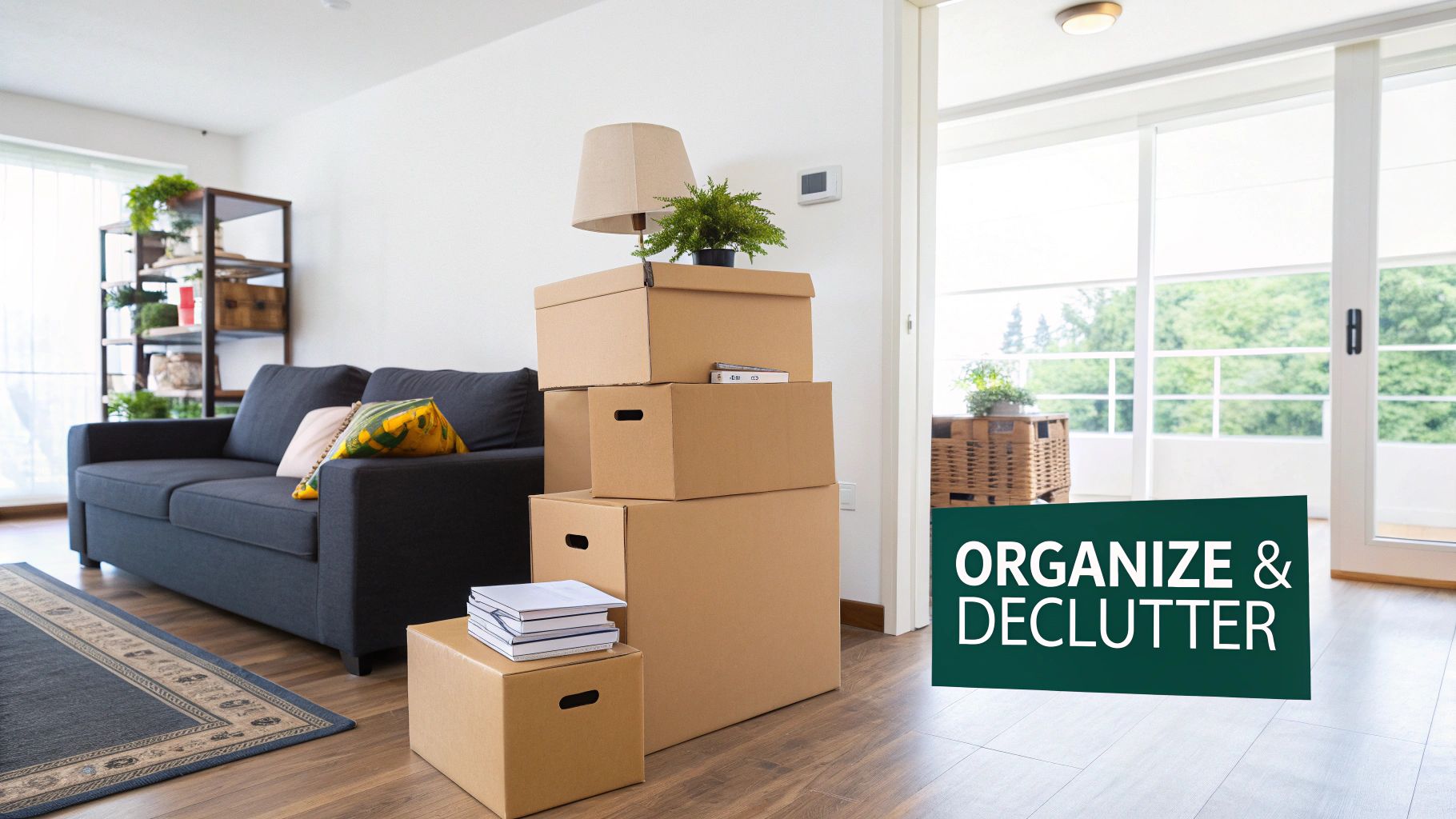
Why a Systematic Purge is Essential
A pre-move purge directly impacts your budget and your mental well-being. Fewer items mean a smaller truck, fewer boxes, and less time spent packing and unpacking. This practice has been popularized by figures like Marie Kondo and is a core principle for professional organizers who manage large-scale relocations. For instance, downsizing retirees often use estate sale companies to efficiently liquidate decades of possessions, while families undertaking international moves can reduce their shipping volume by over 40% through rigorous decluttering.
How to Declutter Effectively
Start this process at least 6-8 weeks before your move date, tackling one small area at a time to avoid feeling overwhelmed. Begin with storage areas like closets, the garage, or the attic, as these spaces often contain items with less emotional attachment.
- Use the One-Year Rule: If you haven't used an item in the past year and it isn't a seasonal or deeply sentimental piece, it's a strong candidate for removal.
- Photograph Sentimental Clutter: For items you cherish but don't have space for, take a high-quality photo to create a digital memory album before letting the physical object go.
- Research Donation Values: Before donating, check the IRS guidelines for the fair market value of your items. A well-documented donation can lead to a significant tax deduction.
- Host a "Take-Away" Party: For items not valuable enough to sell but too good to trash, invite friends and family over to take what they want.
This approach transforms decluttering from a chore into a liberating step toward your new beginning. To master this process, you can learn more about decluttering before a move on Endless Storage.
4. Handle address changes and service transfers
One of the most critical yet tedious things to do before you move is systematically updating your address and managing utility transfers. This administrative task ensures a seamless transition of services, prevents important documents from being lost, and protects you from potential identity theft. Neglecting this step can lead to missed bills, service interruptions, and a frustrating scavenger hunt for your mail weeks after you’ve settled in.
Why a Systematic Approach is Essential
A methodical approach to changing your address prevents the chaos of services being disconnected too early or bills for a home you no longer occupy. It guarantees that crucial mail from the IRS, DMV, banks, and healthcare providers reaches you without interruption. Corporate relocation specialists and military families rely on detailed checklists for this process, as any gap in communication or services can have significant personal and professional consequences. Their structured methods are a proven model for managing these vital administrative updates.
How to Manage Your Updates
Start this process at least four weeks before your move date. Create a master spreadsheet or document to track every organization you need to notify, noting the date you contacted them and any confirmation numbers.
- Prioritize Official Changes: Begin with the most critical entities. File an official change of address with the USPS online, then update your information with the Social Security Administration, IRS, and your state’s DMV and voter registration office.
- Notify Financial and Insurance Providers: Contact all banks, credit card companies, investment firms, and loan providers. Do the same for your health, auto, life, and renter's insurance policies.
- Manage Utilities and Subscriptions: Schedule the disconnection of utilities (gas, electric, water, internet) at your old home for the day after you move out and the connection at your new home for the day you move in. Don't forget to update streaming services, magazines, and any subscription boxes.
This organized approach ensures no account is forgotten, securing your personal information and maintaining continuity of service. For a detailed guide on this process, you can find more information about how to change your address when you move.
5. Secure important documents and records
In the whirlwind of packing boxes and coordinating logistics, some of your most valuable possessions can get overlooked: your essential documents. Creating a dedicated, portable “moving file” for these critical records is a vital step in any list of things to do before a move. This organized system ensures that birth certificates, passports, deeds, and medical records are not accidentally packed, lost, or damaged, keeping them secure and accessible at all times. This strategy transforms a source of major potential stress into a simple, controlled task.
Why a Document Plan is Essential
Losing important paperwork during a move can cause significant delays and complications, from closing on a home to enrolling children in a new school. A secure, organized system prevents this chaos. This approach is standard practice for emergency preparedness organizations like FEMA, which advocate for "go-bags" containing critical documents. Financial and legal advisors also stress the importance of document security, as having these papers readily available is non-negotiable for smooth life transitions.
How to Build Your Moving File
Designate a specific, easily identifiable container, like a fireproof document box or an accordion folder, exclusively for this purpose. This file should travel with you personally, never in the moving truck.
- Categorize and Label: Group documents into logical categories such as Legal, Financial, Medical, and Household. Use clear labels for quick identification.
- Digitize and Back Up: Scan or take high-quality photos of every document and save them to a secure cloud service and an external hard drive. This creates a crucial backup.
- Create a Master List: Include an inventory sheet at the front of your file listing every document contained within. This helps you quickly confirm everything is accounted for.
This dedicated file ensures that your most important information remains safe, organized, and within reach throughout the entire moving process. For a deeper dive into this topic, you can learn more about how to organize important documents on Endless Storage.
6. Plan and pack strategically room by room
One of the most effective things to do before you move is to abandon the chaotic "pack everything in sight" method and adopt a systematic, room-by-room approach. This strategy involves tackling one area of your home at a time, packing non-essential items first and saving daily necessities for last. It compartmentalizes the monumental task of packing, making it far more manageable and ensuring your current home remains livable until moving day.
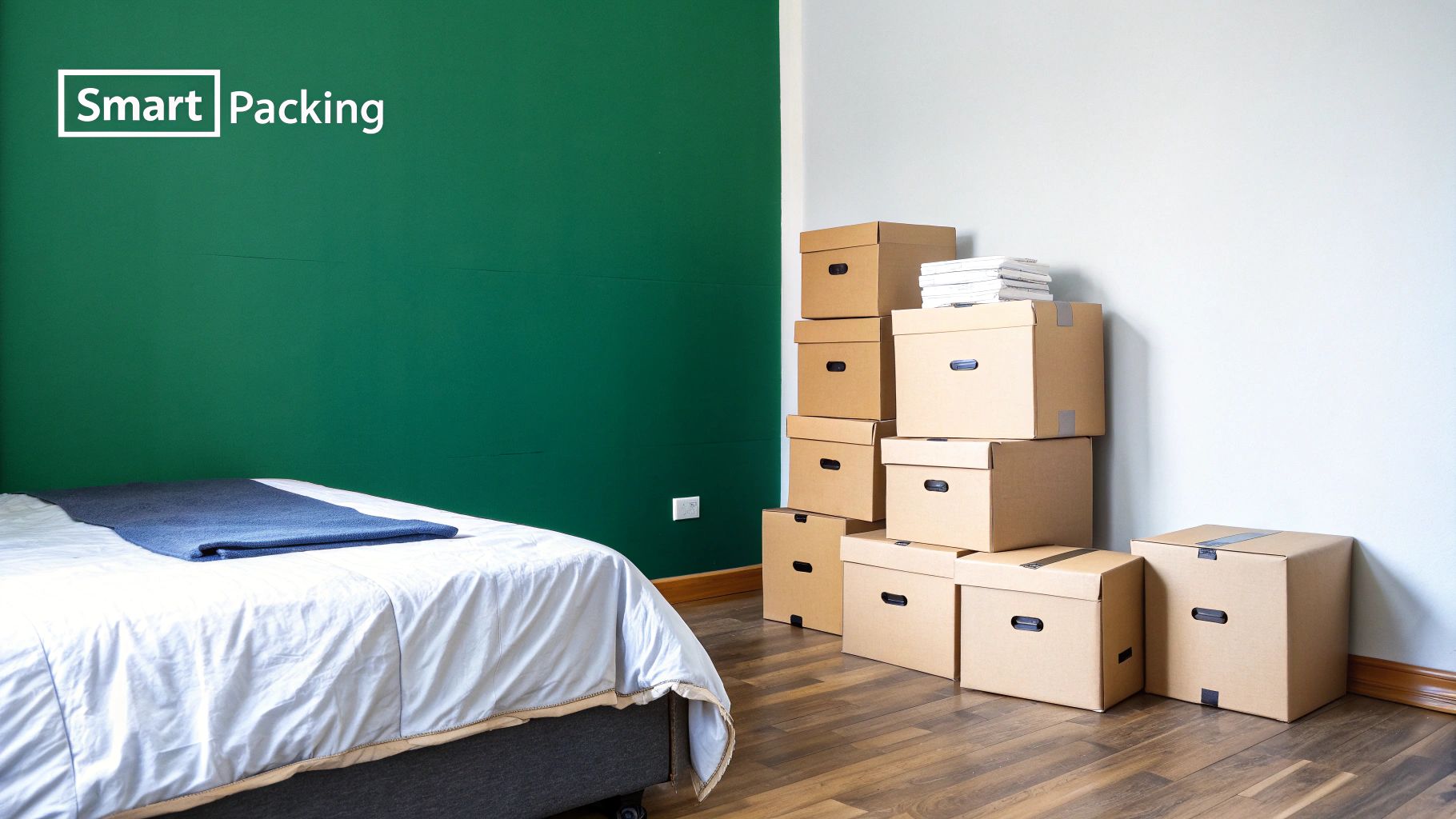
Why a Room-by-Room Strategy is Essential
This method prevents you from having a home filled with half-packed boxes from every room, which creates clutter and confusion. By focusing on one room, you can fully declutter, pack, and label everything before moving to the next, maintaining a sense of order and accomplishment. Professional organizers and moving companies like U-Haul champion this approach because it drastically simplifies the unpacking process. When boxes are clearly marked for a specific destination (e.g., "Master Bedroom" or "Kitchen - Utensils"), movers know exactly where to place them, setting you up for an efficient transition.
How to Implement Your Packing Strategy
Start with rooms you use the least, like a guest room or home office, and work your way to high-traffic areas like the kitchen and primary bathroom. Pack items you won't need in the coming weeks first.
- Prioritize by Use: Begin by packing seasonal items (holiday decorations, winter coats) and rarely used belongings (books, photo albums) 6-8 weeks out.
- Label with Detail: Instead of just "Kitchen," label boxes with specific contents like "Pots and Pans" or "Glassware - FRAGILE" and the destination room.
- Create a "First Day" Box: Pack one box with immediate essentials for your first 24 hours: toiletries, medications, a change of clothes, phone chargers, and basic kitchen supplies.
This methodical approach ensures that by moving day, only the absolute necessities are left to pack, transforming chaos into a controlled and logical process.
The video above provides additional expert techniques for packing efficiently. By implementing a room-by-room plan, you not only streamline the packing phase but also lay the groundwork for a much faster and less stressful unpacking experience in your new home.
7. Arrange school and medical record transfers
One of the most critical logistical tasks when preparing for a move, especially for families, is ensuring a seamless transition of educational and healthcare services. This process involves more than just finding new providers; it requires proactively managing the transfer of vital records to prevent gaps in schooling or medical care. Arranging these transfers early is a cornerstone of a well-planned relocation, safeguarding the well-being and continuity of your family's essential services.
Why Record Transfers are Essential
Failing to properly transfer school and medical records can lead to significant disruptions, such as delayed school enrollment, repeating medical tests, or interruptions in prescription refills. Proactive coordination is a standard operating procedure for groups accustomed to frequent relocations, like military families who rely on portable, comprehensive records to ensure continuity of care across different duty stations. This organized approach minimizes stress and ensures your family’s needs are met from day one in your new community.
How to Manage the Transfer Process
Begin the process at least 4-6 weeks before your move date, as some institutions have processing delays. Your goal is to have all necessary documents in hand or sent directly to the new providers before you arrive.
- Request Early: Contact your current schools, doctor's offices, and specialists to request official copies of transcripts, immunization records, and medical histories. Always keep a personal digital and physical copy for your own files.
- Research New Requirements: Investigate the enrollment procedures for the new school district and the patient intake process for new healthcare providers. They may have specific forms or documentation requirements you need to address ahead of time.
- Verify Coverage: Confirm that your current health insurance plan will provide coverage in your new location. If not, you will need to secure a new policy and ensure your chosen doctors are in-network.
This organized approach is one of the key things to do before you move to prevent last-minute administrative headaches.
8. Budget comprehensively for all moving expenses
Failing to account for the full spectrum of moving costs is one of the most common pitfalls of any relocation. Creating a comprehensive budget goes beyond simply estimating the cost of movers and boxes. It's about building a detailed financial plan that anticipates every expense, from major services to the small, often-overlooked costs that can quickly accumulate. This structured approach prevents last-minute financial stress and empowers you to make informed decisions throughout the process.
Why a Comprehensive Budget is Essential
A detailed moving budget acts as your financial roadmap, preventing unpleasant surprises and ensuring you don't overspend. Financial planners and corporate relocation specialists rely on this level of detail to manage expenses effectively. For example, a cross-country move often requires budgeting between $5,000 and $10,000, and a clear budget is the only way to track and control these significant costs. Without one, you risk misallocating funds and facing unexpected shortfalls.
How to Build Your Moving Budget
Begin by listing every potential expense, categorizing them into groups like "Moving Services," "Packing Supplies," "Travel," and "New Home Setup." This detailed breakdown is a key step in planning things to do before you move.
- Add a Contingency Fund: Unexpected costs are a certainty. Add a 15-20% contingency line item to your total estimated budget to cover unforeseen expenses like last-minute repairs or extra packing materials.
- Get Written Quotes: For major expenses like moving companies or truck rentals, always get at least three written, binding quotes. This prevents price changes on moving day.
- Track in Real-Time: Use a simple spreadsheet or a budgeting app like Mint to log every expense as it happens. This keeps you constantly aware of your remaining funds.
- Explore Savings: Compare the costs of full-service movers versus a hybrid or DIY approach. A local move can often see savings of 50% or more by handling the packing and driving yourself.
9. Prepare an essentials kit for first days
Even the most organized move ends with a sea of brown boxes and the daunting task of unpacking. An essentials kit, often called a "first night box" or "open first" box, is a pre-packed container with everything you need to function comfortably for the first 24-72 hours in your new home. This strategy isolates critical items, so you aren't desperately searching for a toothbrush, phone charger, or important medication amidst the chaos. It’s a simple but powerful way to ensure a smooth, comfortable transition from moving day to your first night.
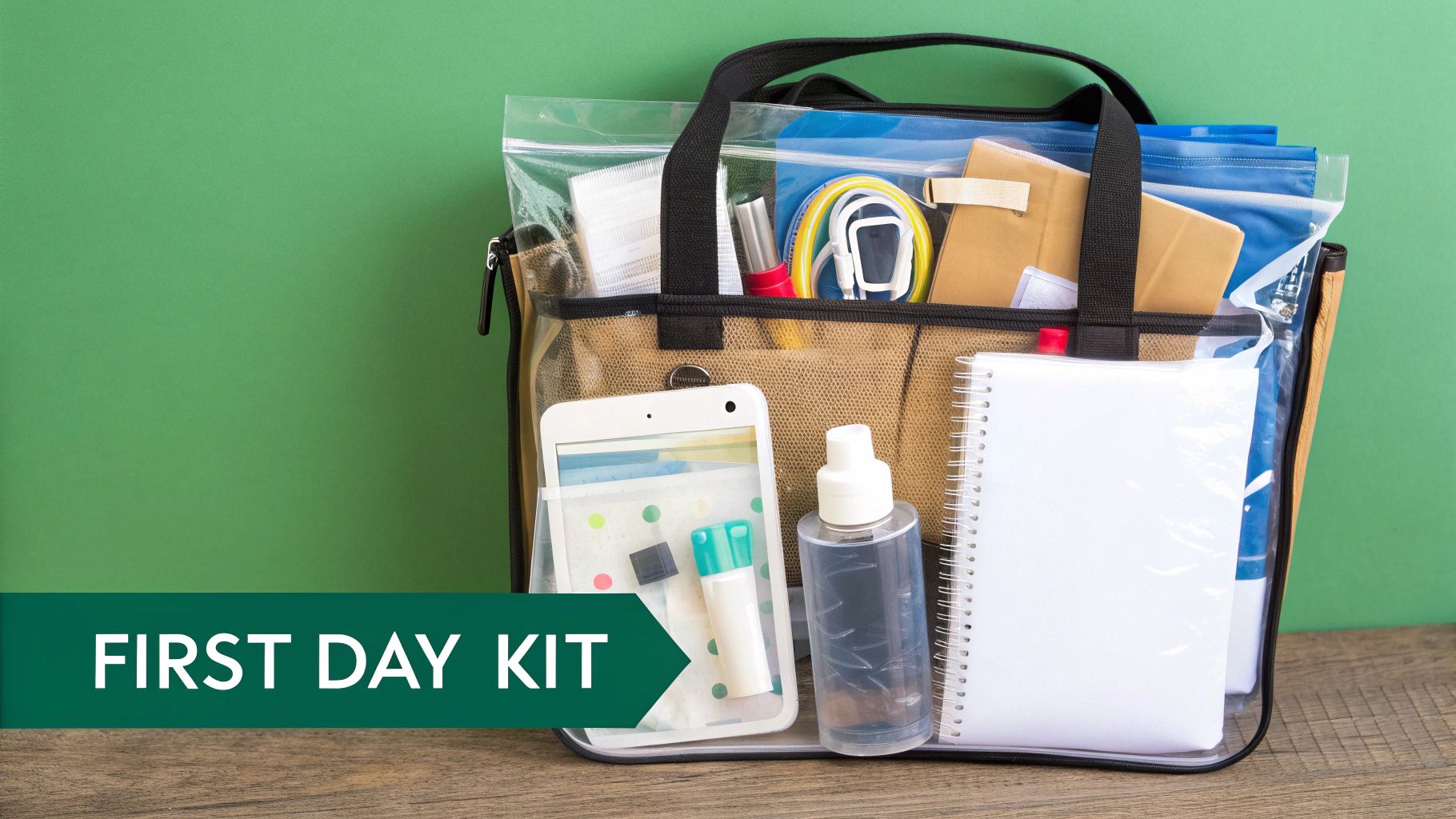
Why an Essentials Kit is Essential
This concept is standard practice for emergency preparedness organizations and military families, who must be ready to set up a functional household immediately upon arrival. For anyone moving, it eliminates the stress of needing an item you can't find. Imagine arriving exhausted after a long day of moving and having immediate access to toiletries, a change of clothes, basic tools, and snacks for your kids or pets without opening a single other box. It turns a potentially frantic experience into a manageable one.
How to Build Your Kit
The key is to think about your immediate needs. What will you, your family, and your pets require to get through the first few days before major unpacking begins? Pack these items last and ensure the box travels with you in your car, not on the moving truck.
- Use a Distinct Container: Pack your kit in a clear plastic bin or a brightly colored, clearly labeled box so it's impossible to miss.
- Think by Category: Gather items for the bathroom (toilet paper, soap, toothbrushes), kitchen (paper towels, disposable plates, snacks, coffee maker), and basic needs (medications, phone chargers, box cutter, first-aid kit).
- Include Comfort Items: Don't forget a favorite toy for a child, a familiar bed for a pet, or a portable speaker to play some music. These small comforts make a new, empty space feel more like home.
This kit is your personal survival pack, making it one of the most critical things to do before move day to guarantee a less stressful arrival.
9-Key Steps Before Moving Comparison
Crossing the Finish Line: Your Move, Mastered
Navigating a move can feel like an overwhelming marathon of tasks, decisions, and deadlines. However, by breaking it down into a series of manageable sprints, you transform a potentially chaotic experience into a controlled and streamlined process. This guide has provided a comprehensive roadmap, detailing the essential things to do before move, turning abstract worries into a concrete action plan.
The journey began with foundational steps: creating a detailed moving timeline and securing professional movers well in advance. These early actions set the stage for success, preventing last-minute scrambles and ensuring you have reliable support. From there, we delved into the critical process of systematic decluttering, a step that not only reduces the physical volume of what you move but also provides a mental reset for your new chapter.
From Logistics to Lifestyle
Managing the administrative side of a move is just as crucial as the physical packing. By diligently updating your address, transferring utilities, and securing all your vital documents, you prevent future headaches and ensure a seamless transition into your new community. This meticulous planning extends to your finances with a comprehensive budget and to your family’s well-being by arranging school and medical record transfers.
Each packed box, when done strategically room by room, represents a piece of a larger, well-executed puzzle. The final, yet arguably most important, piece is your essentials kit. This small, curated box is your lifeline during the first 24-48 hours, providing immediate comfort and convenience amidst the unpacking process. It’s a testament to the power of foresight.
Embracing Your New Beginning
Ultimately, mastering your move is about more than just transporting belongings from one address to another. It’s about taking control, minimizing stress, and setting yourself up to truly enjoy your new home from the moment you step through the door. The preparation you invest now pays significant dividends in the form of a calmer, more organized, and ultimately more joyful moving day.
You have methodically addressed the most critical things to do before move, transforming a monumental task into a series of achievable goals. You've done the hard work of planning, purging, and packing. Now, you are fully equipped to cross the finish line not with exhaustion, but with a sense of accomplishment and genuine excitement for the new beginning that awaits.
As you finalize your decluttering, you might discover items you love but simply don't have space for yet. For a flexible, stress-free solution, consider Endless Storage. They provide by-the-box storage with pickup and delivery right at your doorstep, making it the perfect way to bridge the gap between your old home and your new one. Visit Endless Storage to see how they can simplify your transition.
Frequently Asked Questions
Unveiling the Secrets to Effortless Storage
Endless Storage is available nationwide. You pick a plan, tell us where to pickup, and we'll send a UPS van to collect, whichever state you're in.
Your shipping label will be sent to your email within a few minutes, if not instantaneously. It can also be accessed through your customer profile.
Your box will be shipped to one of our climate controlled self storage facilities in our closest self storage facility. Our manager will accept your package, notify you that your box has been received, and securely stored. Only our managers will have access to Endless Storage boxes.
Email us at admin@endless-storage.com click to live chat with us, or send us a message below.
Never! We're committed to transparent pricing with no surprises. You'll lock in your rate with no hidden fees and no long-term contracts.
Fast access guaranteed! Your boxes will arrive at your doorstep within 48 hours of requesting them back. Need to check on delivery? We provide tracking information for complete peace of mind.
Totally flexible! Store month-to-month with no long-term commitment and cancel anytime.
Everything's online! Use your account dashboard to:
• Set up automatic monthly payments
• Request box returns
• Update your address
• Order additional boxes
• Track shipments
Your boxes are insured up to $100 each. Our customer service team will help you file any necessary claims and resolve issues quickly.
Don't worry – we'll email you right away if there's a payment issue. Your items stay safe, though you may have temporary service interruption or late fees until payment is resolved.
When you request our free storage kits, you'll have 30 days to send in your boxes to activate your 3 months of free storage. Think of it like starting a gym membership – your activation window begins when you receive your kits, and your full free trial begins once you send in your first box. During your free months, you'll experience our complete storage service at no cost.
Your 30-day activation window begins when you receive your storage kits. We'll send you an email confirmation when your kits are delivered, marking the start of your activation period.
If you haven't sent any boxes for storage within your 30-day activation window, your free trial will expire and we'll begin charging the regular monthly rate of $9.99 per box. This helps ensure our storage kits go to customers who are ready to use our service.
A box costs $9.99 per month to store (plus sales tax). This price includes free shipping for standard boxes under 50 lbs. and smaller than 16"x16"x16"
Log into your Endless Storage account, locate the box you would like returned, and simply click Return My Box.
Yes, each box stored with us is insured for up to $100 throughout transit as well as the duration of storage within our facilities.
Your box will be at your doorstep within 48 hours of you requesting it back.
Store 10+ boxes? We'll pick them up for free! After your purchase, we'll contact you to schedule a convenient pickup time and arrange UPS collection.
We trust UPS with all shipments, and every box includes $100 insurance coverage. You'll receive tracking information to monitor your items' journey.
Yes! Visit any of our locations by appointment. Just bring a photo ID matching your customer profile.
For everyone's safety, we can't store hazardous materials, firearms, or perishables. All items must fit within our standard boxes.
It's easy! Order your storage kit online, and we'll ship it to you within 1-2 business days. Your shipping labels will be emailed instantly and available in your account.
We're here to help! Email us at admin@endless-storage.com, use our live chat, or send us a message through your account.
To cancel your storage service with Endless Storage, please email your cancellation request to admin@endless-storage.com. Our team will process your request within 2 business days and confirm your cancellation via email.
We understand packing takes time. However, to maintain your free trial benefits, you'll need to send at least one box within the 30-day activation window. If you need more time, you can always start with one box to activate your trial and send the rest later. You can always reach out to admin@endless-storage.com if you have any issues or concerns.
When you request our free storage kits, you're starting a 30-day window to begin using our storage service.
To avoid any charges, simply send at least one box for storage within 30 days to activate your 3-month free trial. If you decide not to use our service and don't send any boxes within the 30-day window, a one-time $50 fee will apply to cover the costs of materials and shipping. This helps ensure our storage kits go to customers who are ready to use our service.
Think of it like reserving a hotel room – we're setting aside space and sending specialized packing materials for your use. The fee only applies if you request materials but don't begin storage, similar to a hotel's no-show charge.
